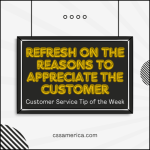Bob and Sarah are arguing, and you’re in the middle. Bob’s an employee, and Sarah is a customer, and they have a difference of opinion. Somehow you’re involved even though you didn’t have anything to do with the interaction in question, the complaint being addressed. You find yourself being the moderator, the mediator, the facilitator.
CSS does a tremendous amount of facilitation work, and it’s not just facilitating disagreements between customers and employees. Usually it’s facilitation of groups where you have various stakeholders meeting, and they all have their own particular interest or position.
The key phrase we use when facilitating conversations like this is Healthy, Productive, and Effective. You want Healthy conversation, where the discussion is about the issue or the goal, not the individuals involved. Make sure people don’t make it personal or take it personal.
Productive means you try to stay on task. Everybody understands up front what the goal is and how much time we have to discuss it, and those things that are not pertinent are identified and put on a “parking lot” for future reference.
Effective means starting with the end in mind and keeping a focus on that end. The end is the goal. It’s not the process to get to the goal. People can get stuck in their specific solution or the process to get to that solution, but you just want them to think about the goal. The more you can get them to focus on a common goal, the better chance you have of getting them there. The more they fixate on their solution or their position or how they want to get there, the more difficult it’s going to be for you to be effective and for participants to get to their goal.
The next time you find yourself in the middle of an argument or a meeting between Bob and Sarah, identify a common goal up front. Try not to get people focused on their position. Make the conversation about the goal and not about the personalities involved. Identify the time constraints, and professionally move the tangents to the parking lot.
Facilitate effectively when you find yourself in the middle.
Signup for FREE Tips! Contact Us More Resources for You Visit Our Home Page
























